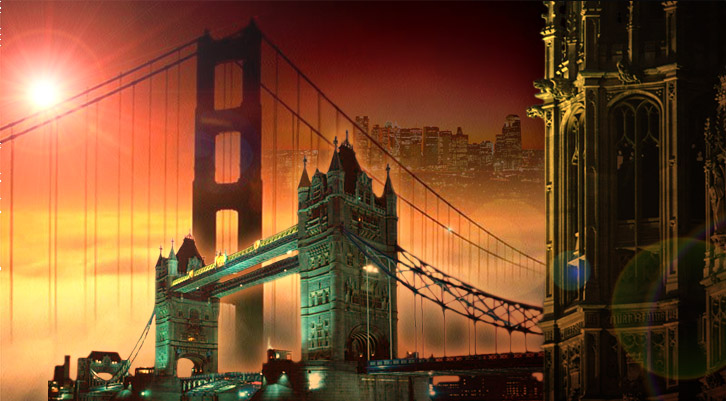 |
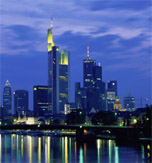 |
USA
"The USA is the fourth largest country in the world after Russia, Canada and China.New-York is the largest city in the USA and one of the largest cities in the world. Two good ways to get the larger picture of New York are to circle it in a bout and to hover over it in helicopter..." |
| |
The USA |
| |
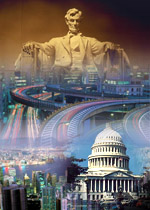 Plan of lecture Plan of lecture
-
-
-
-
-
-
-
-
|
| |
|
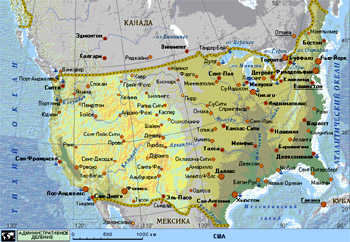
The USA is the fourth largest country in the world after Russia, Canada and China. It occupies the Southern part of the North America and stretches from the Pacific to the Atlantic Ocean. It also includes Alaska in the north and Hawaii in the Pacific Ocean. In 1959 Alaska became 49th state of the USA. Alaska is America’s largest state, but very few people live there. The capital of Alaska is Juneau. After fishing Alaska’s chief industry is lumber and paper production. There are also deposits of coal, copper, gold and other important minerals. The largest island, Hawaii lies at the South-Eastern End of the chain and is almost twice at large as all other islands combined.
The total area of the USA is about 9 and a half million square kilometers. The USA borders on Canada in the North and on Mexico in the South. It also has a sea-border with Russia. The USA is made up of 50 states and the District of Columbia, a special federal area, where the capital of the country, Washington, is situated. The population of the country is about 250 million. The White House, where the US president lives and works, the Capitol, the Home of the US Congress and the Supreme Court are all in Washington. It was named after the first US president – George Washington. It is one of the most beautiful and unusual cities in the US. There are some important museums in Washington, where you can see all kinds of things: famous paintings and sculptures, the original of the Declaration of Independence and etc. People from all parts of the USA come to see their capital.
America’s largest rivers are the Mississippi, the Missouri, the Rio-Grande and the Columbia. The Great Lakes on the border with Canada are the largest and the deepest in the USA. The existence of the Great Salt Lakes was known to early travelers. The climate of the USA varies greatly. The coldest regions are in the North. The climate of the central part is continental. The South has a subtropical climate.
The USA is a highly developed industrial country. It is the world’s leading producer of copper and oil and the world’s second producer of iron ore and coal. Among the most important manufacturing industries are air-crafts, cars, textiles, radio and TV sets and etc.
The largest cities are New-York, Los-Angeles, Chicago, Philadelphia, Boston, San-Francisco and Washington. New-York is the largest city in the USA and one of the largest cities in the world. It is situated in the natural harbor of the mouth of the Hudson river. Manhattan is the smallest island in New-York. The US has its head-quarters there. New-York is the city of sky-scrapers, those incredible high buildings which Americans invented. The city is the national leader in business, finance, manufacturing, advertising, fashion and the arts.
The US is a federal union of 50 states each of which has its own government. The seat of the central government is Washington, DC. According to the US constitution, the powers of the government are divided into 3 branches: the executive, headed by the president, the legislative, exercised by the Congress and the judicial. The Congress consists of the Senate and the House of Representatives. There are two main political parties in the USA: the Republicans and the Democratic.
American society seems to be much more informal than the British and in some way is characterized by less of social distinction. Students don’t stand up when the teacher enters the room. They use names when calling each other, joke and are much freer in their speech which is more slangy than the conversational British English. As a description of character democracy is generally used to signify that a person of high social or economic status in such a way that his or her inferiors are not reminded of their inferiority. Certain other forms of politeness are observed on social occasions: women may wear hats in church. Men who do wear hats ordinarily remove them in elevators, churches, restaurants, private homes, business offices – in fact in most public situations when they wish to show respect.
|
| |
|
 The Unites States of America are situated in the central part of the North American continent. Its western coast is washed by the Pacific Ocean and its eastern coast - by the Atlantic Ocean. The total area of the USA is over nine million square kilometres. The population of the USA is more than 236 million people; most of the population lives in towns and cities. The USA is a very large country, so it has several different climatic regions. The Unites States of America are situated in the central part of the North American continent. Its western coast is washed by the Pacific Ocean and its eastern coast - by the Atlantic Ocean. The total area of the USA is over nine million square kilometres. The population of the USA is more than 236 million people; most of the population lives in towns and cities. The USA is a very large country, so it has several different climatic regions.
The Goldest regions are in the north and north-east. The south has a subtropical climate. The United States is a land of rivers and lakes..The northern state of Minnesota is the land of 10 000 lakes. The longest rivers in the USA are the Mississippi, the Missouri and the Rio Grande. The highest mountains are the Rocky Mountains, the Cordillera and the Sierra Nevada.
The United States are riebiia natural and mineral resources. It produces copper, oil, iron ore and coal. It is a highly-developed industrial Bad agricultural coubtry. There are many big cities in the USA, such as New York, Chicago, Los Angeles, Philadelphia and others. The national capital is Washington, D.C. Its population is about 3,4 million. Washington was built in the late eighteenth century especially as the centre of governmeat. It was named after George Washington. The USA became the world teading country at the beginning of the twenteth century.
|
| |
|
 |
The continental Fleet used this flag in the beginning. |
 |
" The great Union " shown here too referred to " as the Flag of Cambridge. " It flew by on the Hill of Prospect, passing Boston, on January, 1st, 1776. In the top left corner - Sacred Andrey and Sacred Georges's borrowed from the British flag crossings. |
 |
According to some sources, this flag has begun was used in 1777. It was used by the Third полком state of Maryland. Did not exist any official оброзца arrangements of stars on it. A flag bore at Battle Cowpens which took place on January, 17th, 1781, in State of South Carolina in the USA. The flag from that battle hangs in the State residence of State of Maryland. |
 |
In battle at Bennington in August 1777 it was used two known flags. One, shown here, refers to Bennington as the Flag or Fillmore the Flag. Nathaniel Fillmore has taken away this flag home from a field of fight. The flag passed from father to son and now is in Bennington a museum of State of Vermont. Another (not represented) has green area and dark blue canton with 13 stars painted by gold put in numbers. General John Stark has given its New Gempshire to groups after. |
 |
The state of Vermont and State of Kentucky have joined the union in 1791 and 1792. This flag with 15 stars and 15 strips, has been accepted according to the certificate of the Congress 1794. The flag became operating on May, 1st, 1795. |
 |
1818, the union consisted of 20 staffs. The certificate transferred under the mandate of the Congress, that the number of strips, should be 13, and that one new star should be added for everyone new. However, nothing has been written concerning an arrangement of stars. This and the following two flags were used simultaneously. |
 |
Following flag of 1818 (see above). |
 |
One more flag of 1818 (see above). It referred to " the Great Star ". |
 |
After the Mexico-American war in 1846, in the union was 28 states "… |
 |
1861, the nation consisted of 34 states. Even after the south was disconnected from the Union, the President, the Lincoln has not allowed to remove any star. |
 |
In 1912, the United States had 48 states. It would be desirable to pay attention, that there was no official project for a flag with 46 stars, used with 1908 up to 1912. The presidential decree which has established position of stars for this flag has been let out. Presidential orders also were considered at acceptance of flags 1959 and 1960. |
 |
This flag was used in 1959 after also connection of State of Alaska but before Hawaii were included into the Union in 1960. |
|
Flag of the United States today. |
NAME |
SERVED |
ACHIEVEMENT |
| 1. George Washington |
1789-1797 |
The first President, he determi¬ned in large measure what the job of President should be. Held the country together during its early days and gave it a chance to grow. Ranked by historians as a "great" President. |
| 2. John Adams |
1797-1801 |
Saved his country from an un¬necessary war. Ranked by histo¬rians as a "near great" Presi¬dent. |
3. Thomas Jefferson
|
1801-1809
|
Bought the Louisiana Territory and doubled the size of the country. Made sure the govern¬ment stayed in the hands of the people. Ranked by historians as a "great" or "near great" Presi¬dent. |
| 4. James Madison |
1809-1817 |
Allowed the country to get into unnecessary war, but made pea¬ce as quickly as possible. Ranked by historians as an "average" President. |
| 5. James Monroe |
1817-1825 |
Took Florida from Spain. Created the Monroe Doctrine. Signed the Missouri Compromise. Ranked as one of the best of the "avera¬ge" President. |
| 6. John Quincy Adams |
1825-1829 |
Rated by some historians as a failure because little was done during his term. Some historians rank him as "average". |
| 7. Andrew Jackson |
1829-1837 |
Did more to show how great the powers of the office were than any President after Washington. Used these powers to help make laws. Ranked by historians as a "great" or "near great" President. |
| 8. Martin Van Buren |
1837-1841 |
Was caught in one of the na¬tion's worst financial depres¬sions. This was unfairly blamed on him. Ranked by historians as an "average" President. |
| 9. William Henry Harrison |
1841 |
Was President for only one month. |
| 10. John Tyler |
1841-1845 |
Made clear that on the death a President the Vice President became President with all the powers of the office. Served as a President without a party. Ran¬ked by most historians as "below average". |
11 .James Knox Polk
|
1845-1849 |
Bullied a small, weak nation (Mexico) into fighting a war it did not want, but added Cali¬fornia and much of the South-west to the United States. Sett¬led the Canadian border without war. Ranked by historians as a "near great" President. |
| 12. Zachary Taylor |
1849-1850 |
Knew little about the duties of a President but faced his problems honestly though with little poli¬tical talent. Served only two years. Ranked by many historians as "below average." |
| 13. Millard Fillmore |
1850-1853 |
Sent the U. S. fleet to open trade with Japan. Helped pass the Gre¬at Compromise of 1850. Ranked by historians as "below average". |
| 14. Franklin Pierce |
1853-1857 |
Put through the Gadsden Pur¬chase acquiring what is now sou¬thern Arizona and New Mexico. Favored the Kansas-Nebraska Act, which opened the door to the Civil War. Ranked by historians as "below average." |
| 15. James Buchanan |
1857-1861 |
Faced the final breakup of the nation over slavery. Tried hard to prevent war but made matters worse instead of better. Ranked by historians as "below average." |
| 16. Abraham Lincoln |
1861-1865 |
Held the nation together in its most difficult time. In a speech at the Gettysburg battlefield he said it was the people's duty to make sure "that this nation, under God, shall have a new birth of freedom, and that go¬vernment of the people, by the people, for the people, shall not perish from the earth." More than any other one man, he hel¬ped make these words come true. Ranked by historians as a truly "great" President. |
| 17. Andrew Johnson |
1865-1869 |
Took office in a. time of great trouble. Fought for what he be¬lieved was right, but did not have the power to persuade and lead men. Was impeached by Cong¬ress and came within one vote of being removed from office. Ranked by historians from "near great" to "below average." |
| 18. Ulysses Simpson Grant |
1869-1877 |
Was personally honest, but many of the men around him were crooks. His administration was one of the most dishonest in Ame¬rican history. One of the three Presidents rated as a "failure". |
19. Ruthertord
Birchard Hayes |
1877-1881 |
Ended the period of Recon¬struction. Tried to reform the federal government after the Grant administration. Tried to improve the civil service system, but met with little success. Ran¬ked by historians as "average." |
| 20. James Abram Garfield |
1881
|
Was killed only a few months after taking office. Yet his death may have done more to improve honesty in government than he could have done had he lived. |
21. Chester Alan Arthur
|
1881-1885 |
Helped pass the first effective civil service laws and admini¬stered them honestly. Helped develop a modern navy. Ranked by historians as "average." |
| 22 and 24. Grover Cleveland |
1885-1889 and 1893-1897 |
Made needed reforms in the federal government. Helped restore the confidence of the people in their government. His intentions were always good, but his methods sometimes failed. Ranked by historians as a "near great" President. |
| 23. Benjamin Harrison |
1889-1893 |
Favored a strong foreign policy. Enlarged the navy. Wanted a be¬tter civil service, but Congress continually opposed him. Ranked by historians as "average." |
| 25. William McKinley |
1897-1901 |
Allowed the United States to be pushed into war with Spain, but made the United States a world power. Acquired the Philippines, Hawaii, Guam, and Puerto Rico as United States possessions. Ran¬ked by historians as "average." |
| 26. Theodore Roosevelt |
1901-1909 |
Brought tremendous energy and vitality to the office of President. Used the powers of his office to control the power of huge busi¬ness concerns. Worked to estab¬lish national parks and forests and the Panama Canal. Ranked by historians as one of the "near great" President. |
27. William
Howard Taft |
1909-1913 |
Worked hard for conservation of natural resources. Helped impro¬ve the Post Office system. Fought to break the power of the trusts. Ranked by historians as "average." |
| 28. Woodrow Wilson |
1913-1921 |
Reformed the banking laws. Worked to improve the antitrust laws, to help the American wor¬ker, and to lower the tariff. Tried to stay out of World War I, then tried hard to make it a "war to end all wars." Worked for a League of Nations to keep the world at peace. Failed, but left an ideal of which people still dream. Ranked by historians as a "great" President. |
| 29. Warren Gamaliel Harding |
1921-1923 |
In large measure let Congress and his Cabinet run the nation. Was more loyal to his friends than to his country. His was pro¬bably the most dishonest admini¬stration in United States history. Ranked by historians as a "failure." |
| 30. Calvin Coolidge |
1923-1929 |
Believed the powers of the Pre¬sident should be very limited and that government should leave business alone. Took very little action but restored honesty and dignity to the presidency. Ranked by historians as "below average." |
31. Herbert Hoover
Kennedy
|
1929-1933 |
Saw the country plunged into its worst financial depression and was unfairly blamed for it. Tried to improve business, but his efforts were not enough. Ranked by historians as "average." |
32. Franklin
Delano Roosevelt |
1933-1945 |
Saw the United States through two grave crises: the Great Dep¬ression of the 1930s and World War II. Promoted laws that chan¬ged the course of American go¬vernment. Ranked by historians as a "great" President. |
| 33. Harry S. Truman |
1945-1953
|
Was faced by important deci¬sions and made most of them correctly. Established the Tru¬man Doctrine by which the Uni¬ted States would help other nati-ons trying to stay free of Communist control. Worked for social welfare and civil rights laws. Ranked by most historians as a "near great" President. |
| 34. Dwight David Eisenhower |
1953-1961 |
Ended the war in Korea. Tried to lessen troubles with the Soviet Union. Sent troops to Little Rock, Arkansas, to enforce scho¬ol integration. Ranked by most historians as "average." |
| 35. John Fitzgerald |
1961-1963 |
Worked for equal rights for all citizens. Established the Peace Corps. Forced the Soviet Union to withdraw its missiles from Cuba. |
| 36. Lyndon Baines Johnson |
1961-1969 |
Pushed more important laws through Congress than any President since Franklin Roosevelt, including civil rights and antipoverty measures. Tried unsuccessfully to make peace in Vietnam |
| 37. Richard Milhous Nixon |
1969-1974 |
Ended U.S. military involvement in Vietnam. Opened relations with Communist China. His administration was caught in one of the worst political scandals in American history. |
| 38. Gerald Rudolph Ford |
1974-1977 |
His fair and open administration helped to heal the wounds of Watergate. Improved relations with China. Was the first person to occupy the White House with¬out having been elected either President or Vice President. |
39. Jimmy
(James Earl) Carter |
1977-1981 |
Helped bring about a peace treaty between Israel and Egypt. Improved relations with Latin America by giving control of the Panama Canal to Panama. Worked to improve human rights throughout the world. |
| 40. Ronald Wilson Reagan |
1981-1989 |
Built up U. S. military power Worked to reduce inflation and led the fight to reduce taxes. The national debt increased massively during his administration. In his second term, he began arms-limitation talks with Soviet leader Mikhail Gorbachev. |
| 41. George Herbert Walker Bush |
1989-1993 |
His election marked the 200th anniversary of the U. S. presidency. Presided during the breakup of the Soviet Union and the fall of Communist rule in Eastern Europe. In the Persian Gulf war, led a coalition of nati¬ons in driving the Iraqi army out of Kuwait. |
| 42. Bill (William Jefferson Biythe) Clinton |
1993-... |
Won back many of the Democratic and independent voter" who supported Reagan during the previous decade. The first President born after World War II, he took office in a time of transi¬tion. The Cold War was over, and Americans were beginning to fo¬cus on problems at home, inc¬luding the national debt and a sluggish economy. |
| |
|
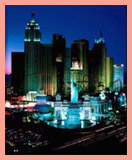 New York attracts people from all over. Get on a subway in New York and look at the newspapers that people around you are reading. One person is reading a newspaper in Spanish, another in Chinese, yet others in Arabic, Russian, Italian, Yiddish, and French. New York was always a city of immigrants. It still is. New York attracts people from all over. Get on a subway in New York and look at the newspapers that people around you are reading. One person is reading a newspaper in Spanish, another in Chinese, yet others in Arabic, Russian, Italian, Yiddish, and French. New York was always a city of immigrants. It still is.
There are 5 boroughs in New York - Manhattan, Brooklyn, Queens, the Bronx, and Staten Island. Brooklyn alone has so many people that if it were a separate city, it would be the fourth largest in the United States.
Manhattan Geography.
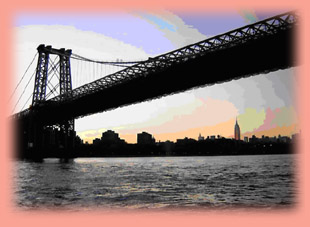 Manhattan is an island just 13 miles long and 2 miles wide . It is the centre of American finance, advertising, art theatre, publishing , fashion - and much more. The borough of Manhattan is what most people think of New York, one of the most exciting cities in the world. Manhattan is an island just 13 miles long and 2 miles wide . It is the centre of American finance, advertising, art theatre, publishing , fashion - and much more. The borough of Manhattan is what most people think of New York, one of the most exciting cities in the world.
Manhattan is divided into the East Side and the West Side. The dividing line is Fifth Avenue. So, for example, East 47th Street begins at Fifth Avenue, as does West 47th Street.
Manhattan is also divided, with less exactness, into Lower (Downtown), Midtown and Upper (Up-town) Manhattan. As you go North, or uptown, the street numbers get higher. Lower Manhattan refers to street numbers below 14th Street and Central Park, and Upper Manhattan to the renaming, northern, part of the island.
The Financial District.
The Dutch were the first Europeans to settle Manhattan. To protect themselves from attacks, they built a sturdy wooden wall. Although it’s now long gone, this wall gave it’s name to a street in Lower Manhattan and the street, in turn, became synonymous with American capitalism. The street, of course, is Wall Street. The New York Stock Exchange and the American Stock Exchange are both in the Wall Street area. So are many stock brokers, investment blanks and others bank, and headquarters of many large corporations.
To escape the commotion of Wall Street you can visit the nearby South Street Seaport, an open area of low buildings on the East River. In addition to many shops and restaurants, the seaport has a museum.
Two good ways to get the larger picture of New York are to circle it in a bout and to hover over it in helicopter. In the financial district, though, there’s another way to see New York. The twin towers of the World Trade Centre rise 1,350 feet above the city. There’s an observation deck on the 107th floor of one of the towers.
Appropriately, the very first business deal in Manhattan was made in what became the financial district. As every American schoolchild knows, the Dutch bought Manhattan from the Indians, for the ridiculously low price of 24 dollars worth of beads and trinkets. There is, however, another, less known side of this: evidently, the Indians who had sold Manhattan did not themselves live there or in any sense own it. The Dutch and the Indians alike walked away pleased.
|
| |
|
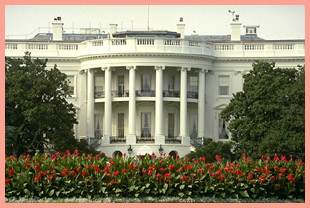 The United States of America is a federal republic consisting of 50 states. Each of which has its own goverment ("state goverment"). In some ways the United States is like 50 small countries. Each state has its own governor, its own police and its own laws. The present constitution was proclaimed in 1787 in Philadelphia, the President is the head of the whole country and the goverment and "commandering chief" of the armed forces. He makes the most important decisions and chooses the ministers, the members of his cabinet. But the President cannot do just what he wants. The Congress must agree first. Americans choose a new president every four years. The residence of the President is the White House in Washington, the Capital city. The goverment of the whole country (the Federal goverment) works from Washington, this is where the Congress is based. The Capitol is the seat of the US Congress. Congress is the American parliament which consists of 2 chambers. The Senate and the House of Representatives. The first Congress met in 1789 in New York city. The membership then consisted of 22 senators and 59 representatives. Today the House of Representatives has 435 members. Elections to the house take place every 2 years. There are 100 senators (2 from each state), they are elected to serve for a period of six years, but every two years elections to the senate took place when one/third of its members must be changed or re-elected. Election day is always in the month of November, on the first Tuesday, after the first Monday. Americans who aren't yet 25 years old have no right to be elected to the House of Representatives. Whose, who are under 30 can't be elected in the Senate. The main political parties in the United States of America are the Democratic Party and the Republlican Party. The United States of America is a federal republic consisting of 50 states. Each of which has its own goverment ("state goverment"). In some ways the United States is like 50 small countries. Each state has its own governor, its own police and its own laws. The present constitution was proclaimed in 1787 in Philadelphia, the President is the head of the whole country and the goverment and "commandering chief" of the armed forces. He makes the most important decisions and chooses the ministers, the members of his cabinet. But the President cannot do just what he wants. The Congress must agree first. Americans choose a new president every four years. The residence of the President is the White House in Washington, the Capital city. The goverment of the whole country (the Federal goverment) works from Washington, this is where the Congress is based. The Capitol is the seat of the US Congress. Congress is the American parliament which consists of 2 chambers. The Senate and the House of Representatives. The first Congress met in 1789 in New York city. The membership then consisted of 22 senators and 59 representatives. Today the House of Representatives has 435 members. Elections to the house take place every 2 years. There are 100 senators (2 from each state), they are elected to serve for a period of six years, but every two years elections to the senate took place when one/third of its members must be changed or re-elected. Election day is always in the month of November, on the first Tuesday, after the first Monday. Americans who aren't yet 25 years old have no right to be elected to the House of Representatives. Whose, who are under 30 can't be elected in the Senate. The main political parties in the United States of America are the Democratic Party and the Republlican Party.
|
| |
|
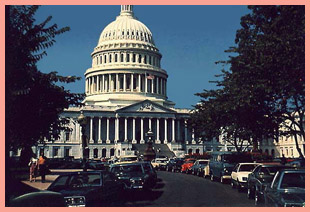
The city of Washington, the capital of the United States of America is located in the District of Columbia (DC for short) Many people consider Washington DC to be one of the most beatiful cities in the world. It is filled with many parks, wide streets and impressive buildings. In the centre of the city, in Capitol Park, visitors' eyes focus on the Capitol, where Congress convence to inect laws. Many visitors come to Washington DC to see the White House. It is the greatest attraction for many of them. The White House, the official residence of the President, is situated at 1600 Pennsylvania Avenue, N.W. The largest room in this building of over the hundreds room is the East Room, scene of many state receptions, balls and musicals. Other famous rooms are: the Green Room, the Blue Room, the Red Room, which are used for afternoon teas and for receptions held before state dinners. The Blue Room, the most formal of these "colors" room is an oval-shaped room connecting the Green and the Red Rooms. On the second floor, the floor with the family quarters and quests rooms, is the Lincoln Room, which one served as an office for president Lincoln but today serves as an honor guest room. In this room Lincoln signed the emansipation proclamation of 1863. Other landmarks in Washington DC include memorials to three Presidents: The Washington Memorial, The Lincoln Memorial and The Jefferson Memorial; The Library of Congress, The National Gallary of Art, The John F. Kennedy center for the Perfoming Arts. The Capitol is in the very center of Washington. It is located on the
Capitol Hill, the highest point in the city. The Capitol is the highest building in Washington. There is a law in Washington not to build buildings higher than the Capitol. The conrer stone of the Capitol was laid by George Washington on Sep 18th, 1793. The Capitol is the seat of the goverment of the United States of America.
|
| |
|
|



The Unites States of America are situated in the central part of the North American continent. Its western coast is washed by the Pacific Ocean and its eastern coast - by the Atlantic Ocean. The total area of the USA is over nine million square kilometres. The population of the USA is more than 236 million people; most of the population lives in towns and cities. The USA is a very large country, so it has several different climatic regions.
 Plan of lecture
Plan of lecture











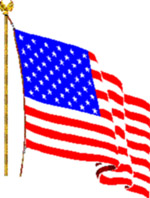


 The United States of America is a federal republic consisting of 50 states. Each of which has its own goverment ("state goverment"). In some ways the United States is like 50 small countries. Each state has its own governor, its own police and its own laws. The present constitution was proclaimed in 1787 in Philadelphia, the President is the head of the whole country and the goverment and "commandering chief" of the armed forces. He makes the most important decisions and chooses the ministers, the members of his cabinet. But the President cannot do just what he wants. The Congress must agree first. Americans choose a new president every four years. The residence of the President is the White House in Washington, the Capital city. The goverment of the whole country (the Federal goverment) works from Washington, this is where the Congress is based. The Capitol is the seat of the US Congress. Congress is the American parliament which consists of 2 chambers. The Senate and the House of Representatives. The first Congress met in 1789 in New York city. The membership then consisted of 22 senators and 59 representatives. Today the House of Representatives has 435 members. Elections to the house take place every 2 years. There are 100 senators (2 from each state), they are elected to serve for a period of six years, but every two years elections to the senate took place when one/third of its members must be changed or re-elected. Election day is always in the month of November, on the first Tuesday, after the first Monday. Americans who aren't yet 25 years old have no right to be elected to the House of Representatives. Whose, who are under 30 can't be elected in the Senate. The main political parties in the United States of America are the Democratic Party and the Republlican Party.
The United States of America is a federal republic consisting of 50 states. Each of which has its own goverment ("state goverment"). In some ways the United States is like 50 small countries. Each state has its own governor, its own police and its own laws. The present constitution was proclaimed in 1787 in Philadelphia, the President is the head of the whole country and the goverment and "commandering chief" of the armed forces. He makes the most important decisions and chooses the ministers, the members of his cabinet. But the President cannot do just what he wants. The Congress must agree first. Americans choose a new president every four years. The residence of the President is the White House in Washington, the Capital city. The goverment of the whole country (the Federal goverment) works from Washington, this is where the Congress is based. The Capitol is the seat of the US Congress. Congress is the American parliament which consists of 2 chambers. The Senate and the House of Representatives. The first Congress met in 1789 in New York city. The membership then consisted of 22 senators and 59 representatives. Today the House of Representatives has 435 members. Elections to the house take place every 2 years. There are 100 senators (2 from each state), they are elected to serve for a period of six years, but every two years elections to the senate took place when one/third of its members must be changed or re-elected. Election day is always in the month of November, on the first Tuesday, after the first Monday. Americans who aren't yet 25 years old have no right to be elected to the House of Representatives. Whose, who are under 30 can't be elected in the Senate. The main political parties in the United States of America are the Democratic Party and the Republlican Party.